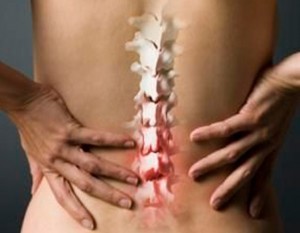Currently, a large number of people suffer from osteochondrosis. Many of them do not know about the problems that exist. Meanwhile, if you do not start treatment on time, complications will occur that make them feel you for the rest of your life. Osteochondrosis, like many other diseases, “gets younger” and significantly worsens quality of life, dropping it from its normal rhythm.
In our article we will learn a little about the disease itself, as well as discuss in detail the medical methods of its treatment.
Osteochondrosis and its types
Osteochondrosis is a deformation of articular cartilage, spinal cord tissue and intervertebral discs.
Osteochondrosis occurs:

- lumbar (lumbosacral),
- cervical,
- dada.
Causes of osteochondrosis:
- walking upright,
- curvature of the spine,
- spinal injuries,
- flat feet,
- lift weights often,
- frequent body position changes,
- stay long in an uncomfortable position,
- spine advantage,
- physical inactivity and obesity,
- malnutrition,
- depressed state.
Stages of osteochondrosis
- Due to certain changes in the intervertebral disc, vertebral instability appears. The spine is very prone to injury.
- The onset of intervertebral disc fibrous ring destruction occurs. The intervertebral disc is reduced.
- The fibrous annulus ruptures. The nucleus pulposus of the intervertebral disc stands out. Due to the formation of an intervertebral hernia, spinal deformities are provoked.
- Significant pain syndrome occurs. Due to the formation of bone growth and oscillation of the spinal ligaments, movement becomes limited.
Symptoms of osteochondrosis
Lumbar (lumbosacral) area
- Persistent back pain.
- Pain and numbness in the limbs.
- Decreased physical activity.
- Increases pain when performing sudden movements, lifting weights, exercising, sneezing and coughing.
Cervical region
- Pain in arms and shoulders, headache.
- Vertebral artery syndrome (throbbing headache, dizziness, headache, colored spots and "flies" in front of eyes)
Thoracic Region
- Pain in internal organs, especially in the chest ("pillar" in the chest) and the heart area.
Determining the diagnosis
Diagnosis is made based on the appointment of a neurologist based on patient complaints (pain syndrome, movement limitations, etc. ). The spine is examined by him while the patient is standing, sitting and lying down (in a state of rest and movement). When examining the back, attention is paid to posture, body structure features, lower corners of the shoulder blades, lateral contours of the neck and waist, shoulder belt position, etc. Afterwards, the doctor, as a rule, directs the patient for X-rays, computed tomography or MRI, with the help of which the diagnosis is clear and concrete, the degree of damage is determined, and hidden deviations from the norm are stated. Based on the data obtained, the neurologist prescribes appropriate treatment. As a rule, this is a complex therapy, which includes the use of drugs, massage, exercise therapy and other methods.
Therapeutic exercises for lumbar spine osteochondrosis

Treatment of osteochondrosis with medications
For starters, it should be noted that in the early stages of the development of osteochondrosis, in some cases you can do without medication. Enough with the use of medical gymnastics, all kinds of applicators, as well as to reduce the load and eliminate the causes of other diseases. If symptoms worsen, and studies show characteristic changes, medications should be used to help influence the causes and symptoms of osteochondrosis.
Treatment of osteochondrosis with drugs is indicated during its exacerbation period and aims to relieve the inflammatory process, relieve pain and improve metabolic processes due to internal intake or administration of drugs using injections.
Since osteochondrosis is a systemic disease that negatively affects various organs and systems, its treatment should be comprehensive. Medications for the treatment of osteochondrosis perform the following tasks:
- relieves pain,
- removal of inflammation,
- improves blood circulation in the affected tissue,
- cartilage recovery,
- restores mobility in joints,
- elimination of depression caused by persistent pain.
So, what medications can a neurologist prescribe to treat osteochondrosis?
- NSAIDs (non-steroidal anti-inflammatory drugs).
Eliminates inflammation and pain. They are used externally (gels, creams), internally (capsules, tablets), as well as in the form of injections (intramuscular, intravenous, subcutaneous).
- Vasodilators (vasodilators).
As a result of muscle tension and pain in osteochondrosis, narrowing of blood vessels occurs. To avoid unwanted consequences with this background, the doctor may prescribe a vasodilator medication for a better restorative effect.
- Muscle relaxer.
Muscle relaxation has a relaxing and calming effect on the muscles. The healing process without medication from this group goes slower, because due to its nature, blood circulation is normalized, the sensation of dull pain, movement back, and the affected tissues recover faster.
- Chondroprotectors.
Chondroprotectors do not provide further destruction, they stabilize the situation. Taking chondroprotectors is long-term, lifelong, the effects occur after treatment for at least 6 months. Chondroprotectors are used externally, internally and in injectable form.
- glucosamine
- kondroitin
- glucosamine + chondroitin
- glucosamine + chondroitin + vitamin
- Sedative (sedative).
Long-term pain syndrome can trigger stress and depression. In this case, a preparation of valerian, motherwort, a combination of herbs is prescribed. For more severe disorders, antidepressants are used, and hypnosis is used to improve the process of sleep and sleep quality.
- Vitamins and vitamin-mineral complexes.
Vitamin B is very important here, as it can restore the sensitivity of the affected nerve fibers and reduce pain.
For the purpose of strengthening the body in general, vitamin and mineral complexes can also be prescribed.

























